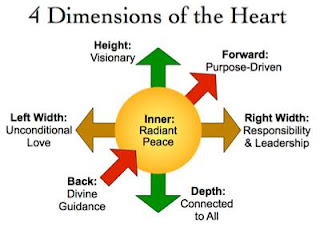Some really lovely quotes on the dimensions of the heart.
Extend the heart forward
---------------------------------
There
is a thread that runs through all the events of your life, like the
cord that strings the beads in a necklace. Looking back over your life,
can you see a consistent interest in some subject, kind of activity,
type of person, or aspiration? This is a clue to the purpose of your
life. Your purposewas engraved into your heart before conception, that
you might eventually discover it there and make it your conscious wish.
Your
heart’s wish begins like a delicate plant -- it needs care and frequent
watering. As it matures, it gets hardier, but it still needs a little
fence around it for protection. Later it becomes like a tree that can
stand up even to powerful winds. It sends out branches that create a
micro ecosystem on which other plants, animals, birds and insects
depend. Eventually it becomes a forest. The heart’s wish has become your
whole life.
Height of the heart
-------------------------
The
development of the conscience is not a rational process; it’s a result
of the development of height in the heart. Everyone has a conscience:
there is sportsmanship among hunters; there are things that soldiers in
battle won’t do; there is some honor even among thieves. Yet there are
those who, because of conscience, would not hunt, do battle, or steal.
The degree to which the conscience is developed is an indication of the
height of the heart. A highly developed conscience places more
restraints on a person, as appropriate for an idealistic person. If the
heart is not elevated, then one’s conscience is easier to live with.
Depth of the heart
------------------------
The
depth of your heart is its most precious and vulnerable place. It is
here, at the Solar Plexus, just below the ribcage, that the heart feels
the greatest and most transpersonal emotions: unconditional love,
inconsolable sorrow, unspeakable bliss, unending communion with all
life. In short, the symphony of cosmic emotions that J.S. Bach expressed
in the Mass in B Minor is here in the depth of your heart all the time.
Occasionally something happens to create an access point to one of
these great emotions and it rises toward the surface of the heart where
it becomes more conscious.
When your heart is energized,
the world becomes a much more beautiful place, and the tragedies of life
become even more tragic. It’s like watching a full-color movie when
you’re used to black and white -- everything seems more real than it did
before. Without an energized heart, you couldn’t stand it -- you’d have
to turn down reality by fleeing into your mind, which filters out
anything it can’t understand. With your heart open and strong, you see
beauty and tragedy, both, right in front of you and at distances
previously inconceivable.
Width of the heart
------------------------
The
path of the heart is not the path of freedom; it is the path of
responsibility. There are many who depend upon you: some for a smile, a
greeting, an insight. Some need you to pull your weight, others need you
to pull them. You provide energy, leadership, security, and love to
some, and receive the same from others. Your heart is part of a network
of hearts that circulates the energy of love through humanity, and you
are a vital link in that network. Whatever you can contribute to others
will circulate and return to you augmented.
Inner dimension
---------------------
The
inner dimension of your heart is your treasure of heart energy, ready
to be drawn upon to respond to change or to be drawn out into one of the
other dimensions. This inner wealth can be built up and spent down,
like a bank account. However, unlike a bank account, you have to pay
interest on that heart energy that you’ve saved up and haven’t used. The
heart is not a perfect container -- every heart has been wounded in
life and its wounds have caused holes, like ulcers, that leak its stored
energy. As long as the heart is being recharged, these leaks are not
noticeable, but if the inspiration into the heart is stopped or slowed
significantly, then the level of energy in the heart drops. If it drops
enough, one slips from optimism into pessimism.
Optimism
is the natural condition of a full heart but if the heart is emptied,
optimism cannot be sustained. Everyone would like to be optimistic, but
it can’t be done by will; it requires energy. Your emotional heart may
also have developed deadened parts, like scar tissue in a physical
heart, where the feeling is lost. These areas are hard.





